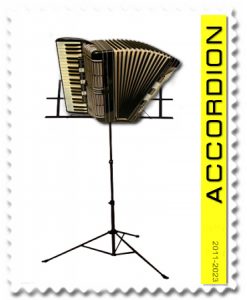Accordion
The portative consisted of a small keyboard, bellows, and reed pipes, and was strapped onto the player:
- 1822 – F. Buschmann invented small portable keyboard, with free vibrating reeds inside the instrument itself, He dubbed it the hand-aeoline
- 1829 – Cyrillus Damian, a Viennese instrument make design featured two to four bass keys that produced chords within a range of an octave
- 1829 – Sir Charles Wheatstone was awarded the British Patent No. 5803 for his concertina
- 1832 – The first music book featuring both music and arrangements was written by A. Reisner
- 1850 – The chromatic accordion, which produced the same note on the press and the draw of the bellows
- 1877 – Schrammel accordion had 52 treble buttons arranged in three rows that produced the same notes
The modern accordion has three primary sections, the expandable bellows and the two wooden end units called the treble and bass ends. The treble end of the accordion has a keyboard attached. The bass end contains finger buttons that play bass notes and chords. The reeds and electronic components are located on the inside of the bellows. The accordion is called a free reed instrument because it uses free-standing reeds to produce sound, similar to the harmonica. The reeds are made up of metal strips that are riveted to either side of a rectangular metal plate. When air passes through this slot in the appropriate direction the reed vibrates, producing the characteristic accordion sound. There are three main styles of accordion: diatonic, chromatic and keyboard. One of recent invention is an accordion attachment that allows the musician to modify notes by bending the tone
wikipedia – Glossary of Musical Terminology, www.encyclopedia.com, www.coolinarism.org, www.cavitas-air.comm
according – project stamps 2003-2020
